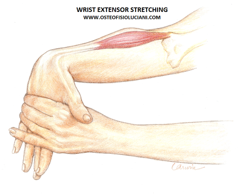Lateral epicondylitis, commonly known as tennis elbow, is a painful condition involving the tendons that attach to the bone on the outside (lateral) part of the elbow. The muscle usually involved in this condition, the extensor carpi radialis brevis, helps to move the wrist and maintain a grip position. This muscle is used in any racquet sport (such as tennis or squash), gripping action, typing and any hand use, even games on the phone.
As lateral epicondylitis starts to develop there is often an initial stage of overuse of the forearm. This may involve excessive use of the extensor muscle group without adequate rest or stretching. Do you think to stretch your forearms after finishing an exam or assignment or after a day at the office?
After prolonged overuse of the carpi radialis brevis muscle it starts to pull on its attachment (the lateral epicondyle) and begins to create micro tears at the attachment site, which is what makes this condition so painful.
This condition can occur at any age, however it is most common around 35-50 years of age.
Causes
Contrary to the name, you do not have to play tennis to develop the condition. We often see this strain & overuse pattern in Tradies (painters, carpenters, bricklayers and chef’s), people who play musical instruments professionally or for a hobby, people who regularly use a computer or phone or even someone taking up knitting.
Symptoms
Pain aggravated by use and worsening, for example, pain may begin to occur if you play two games of tennis in a row. As the condition worsens, it can develop into pain when turning a door handle or lifting a tea cup or kettle. It is often better with rest. The pain is located over the most lateral (outside) part of the elbow & may radiate into the forearm.
This condition can be confused with pain referring from the Cervical spine, i.e. a disc bugle, radial nerve entrapment or a fracture. A thorough case history and thorough assessment will usually allow your doctor, osteopath or chiropractor to ascertain what is causing the symptoms.
Do I need to have images?
A scan is not normally necessary for diagnosing this condition. The condition is usually diagnosed by a simple physical examination by your practitioner. However an Ultrasound may be used to asses for any calcification or tearing which may assist with treatment options or an X-ray may be used to assess for any fractures, stress fractures, osteophytes or degeneration.
What are the treatment options?
- Ice
- Rest
- Brace or kinesiology tape
- Corticostreiod injection
- Trigger point dry needling
- Stretches
- Improving technique, mechanics, racquet use
- Strengthening exercises
- New research is surfacing about Platelet-rich plasma (PRP), which is a new technique for increasing the healing process by injecting your own blood plasma, which is rich in growth factor into the injury site, over the attachment of the extensor carpi radialis brevis tendon. More information about this technique may be available by seeing your GP, however it is still in the early stages of becoming mainstream treatment for this condition.
- Surgery is only recommended after conservative management has failed and the pain is incapacitating after 6 months of trying conservative management
Above: the stretch for the extensor carpi radialis brevis (Image from http://www.osteofisioluciani.com/en/epicondylitis)
If you are experiencing any arm or elbow pain, our team of Osteopaths and Chiropractors would be happy to give you an assessment, please contact Body of Life Health Centre on 9453 3046, or book online at www.bodyoflife.com.au
Article written by Dr Alex Kleydish (Osteopath)


